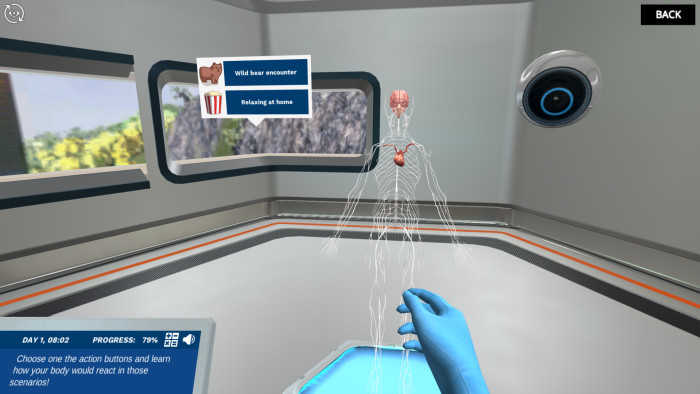
The nervous system is an incredibly complicated and exhausting topic of study. Each of the cell types and tissues in this organ system has an intricate structure and a complex function. At the same time, learning about how the nervous system functions is irrefutably significant in medicine and biology.
How can educators condense this intensive subject matter and present it to students in an engaging way? Here, we list five engaging ways to teach students about the gross function of the nervous system so they can easily learn this challenging topic.
Physiological functioning of the nervous system involves a host of well-connected cells and tissues and a series of well-timed steps. Interactive models help highlight the particularly intricate components and connections of the nervous system by offering a tangible, manipulatable structure.
Take Labster’s ‘gross function of the nervous system’ simulation, for example. This interactive simulation gives the students a closer, dissected look into the microanatomy of a neuron. In our simulation, the students also:
· Familiarize themselves with different neuronal components, like axon, dendrites, cell body, etc.
· Learn about three different types of neurons – sensory neurons, motor neurons, and interneurons.
· Get to interactively put together these different types of neurons by picking and assembling the right cell components.

Games and activities coalesce a classroom like never before, creating an atmosphere of collaborative learning that provokes the students’ curiosity. Teaching the arduous principles of neuroscience through games and activities can reduce the burden on educators as well as students.
For example, you can engage your students in an immersive puzzle. They will have to put together different types of neurons to build a connection from the brain to a muscle. As they do so, the students will also learn about the different types of neurons and their unique functions.
Topics like the nervous system are difficult to teach in a classroom or even in conventional laboratory settings. Classrooms can get too dull, and laboratories too sophisticated, especially for beginners. Such challenging topics demand a visual component that only advanced technologies – like animation, simulation or augmented reality – can offer.
For example, in Labster’s ‘gross function of the nervous system’ simulation, students enter a virtual lab and learn about neuronal communication, neuronal cell components, and the differences between the central and peripheral nervous systems. They do so by virtually applying sophisticated laboratory and computational techniques like dissection, microscopy, and 3D modeling. This technology-enhanced learning experience makes the nervous system an exciting topic of study.

Discover Labster's gross function of the nervous system virtual lab today!
It is natural for students to attach value to a topic of study through the career opportunities it can offer. The attached value then determines how much time and brainpower they are ready to invest in the topic. Inspire your students by clearly putting forth the various career opportunities that learning about the nervous system can offer.
For example, you can invite neurobiologists and neurologists to engage in in-depth discussions with your students. These professionals can best communicate the exact role that every subtopic in your class plays in their daily work lives. You can also take your students to a neurobiologist’s workstation in a lab. Here, the students can learn significantly from live demonstrations of everyday techniques that a neurobiologist uses.
Educators need to dive into the microscopic level to teach the complexities of the different components of the nervous system. While that is all well and good, the microscopic level can disconnect the students from the big picture – real-world applications. Establishing connections with real-world applications can ensure that students realize the gross-level outcomes of the goings-on at the microscopic level.
For example, talk to your students about how dysfunctional neuronal communication could result in autism. Explain to them the role that interneurons play in autism, schizophrenia, and other neuropathological conditions. These links to real-world scenarios can inspire your students to learn the subject matter more sincerely.
The nervous system is a layered topic that requires educators to cover everything from cell biology to gross physical function. By using the teaching methods we have discussed here, you can make the nervous system an engaging topic of study.
Try our free 30-day All Access Educator's Pass today and teach with the Gross Function of the Nervous System simulations alongside 300+ other virtual labs!

Labster helps universities and high schools enhance student success in STEM.
Request DemoRequest a demo to discover how Labster helps high schools and universities enhance student success.
Request Demo